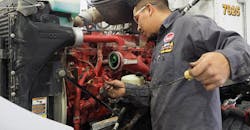Editor's Note: The following story by Aaron Marsh, senior editor for our sister publication Fleet Owner, highlights some changes in engine lubrication technology. We thought the information could be useful for auto parts distributors who maintain their own vehicle fleets.
There's a brave new world of fuel efficiency and operational savings in trucking—one that's enabled more by a combination of advanced engine hardware and oil technology than ever before. It only waits for fleets to embrace it, but you should also be thinking additives when selecting the right engine lubricant.
Sure, the trucking industry changes oil — drains it, that is. But when it comes to changing the type of oil itself fleets are used to using, that's a different story.
Nearly two years ago now, a page turned and a very significant new chapter began for oil in the United States. New, better-quality, more technologically advanced engine oil hit the market, promising fleets and trucking companies multiple benefits. So far, though, many have chosen not to change the status quo.
That's very much in-character. This is an industry that has long been skeptical and reluctant concerning changes to engine oil and big diesels in particular, and fleets need to keep their equipment protected.
"Prior to 1980, we were happy with an SAE 30 oil in both four-stroke and two-stroke diesel engines," says Mark Betner, heavy duty lubricants manager at Citgo Lubricants. He's spent 40 years in the lubricants industry, with 30 of those at Citgo, and has been active for decades in the American Trucking Associations' (ATA) Technology and Maintenance Council.
"A lot of automotive engineering research took place then" around 1980, he says, and a new advancement in oil was coming onto the scene. It was 15W-40 oil.
"I remember sitting in front of a very large fleet in the early '80s trying to explain why 15W-40 engine oil would be an improvement over SAE 30," notes Betner, speaking during a recent Fleet Owner webinar on the latest oils. "I explained that it would reduce engine wear; it would reduce upper engine deposits. It would even reduce oil consumption."
The fleet decision-maker in front of him "was very courteous" and listened through the whole spiel, he recalls. "At the end, he said, 'That was a good presentation, but I want you to take something back to your engineering friends for me.' I said, 'What's that, sir?'
"He said, 'Tell them that a 15W-40 will never work in a diesel engine.'"
All suspiciousness and reluctance aside, 15W-40 did work very well in diesel engines. It's been the most common oil viscosity grade around in fleet trucks across America for decades. But the latest engine oil options have now surpassed that stalwart oil.
For starters, says Betner, a 15W-40 is still a fairly thick oil to pump through an engine, and its performance in the cold is limited. "If you live in a northern state and experience those frigid, cold temperatures, keep in mind that a 15W-40 oil is only good down to about 15 degrees," he points out. One of the new lower-viscosity oils, if approved for a fleet's trucks, can offer cold startup protection down to minus 20 degrees or even colder.
Citgo has done "cold box" testing, he explains, and found that at water's freezing point of 32 degrees, a 5W-type oil is five times easier to pump than a 15W-40 oil. "So you can see how that might translate to less wear, longer starter life, longer battery life, and even reduced dependency on block heaters," Betner says.
Making a selection
Just like 15W-40 once offered advantages over predecessor oils that had been the norm, the new categories of oil that came out in December 2016 are better at protecting engines. In short, they can offer more resistance to oxidation and oil breakdown, where oil becomes thicker under extended high heat, and improved engine component protection at temperature extremes, both high and low. Some can even help trucks burn less fuel.
It began some years ago now as the American Petroleum Institute (API) started work on the next generation of oil specifications in 2011. At the time, oil in the U.S. fell into the category called CJ-4 dating back to 2006. API dubbed the new oil specs "Proposed Category 11," or PC-11 for short, which ended up being split into two categories, CK-4 and FA-4.
CK-4 oil was so named because it came with improved protection and resistance to oxidation and breakdown while being fully backwards-compatible with the old CJ-4 category. It was intended to be an obvious next sequential step forward.
The FA-4 category was named to show, right from the start, a more radical departure from the prior category as a "first of its kind." It offers improvements and advantages beyond CK-4, in part through lower viscosity that reduces friction in the engine yet still protects the engine and its components, with no reduction in engine durability. Less internal friction means it takes less energy—and less fuel burned—to move those engine parts around.
FA-4 oils may not work properly with older engines, although engine manufacturers are still testing these new oils to determine which engines can use them. Today's manufacturing processes are very precise with tight tolerances, and as the latest engines employ technologies to eke out every ounce of power and reduce emissions as much as possible, they tend to run hot and under higher pressure.


